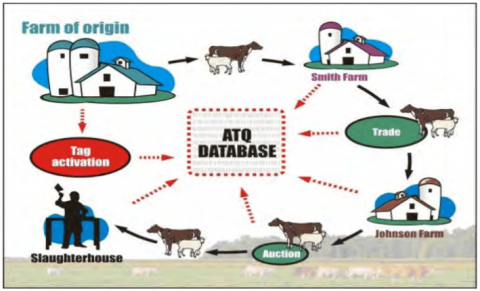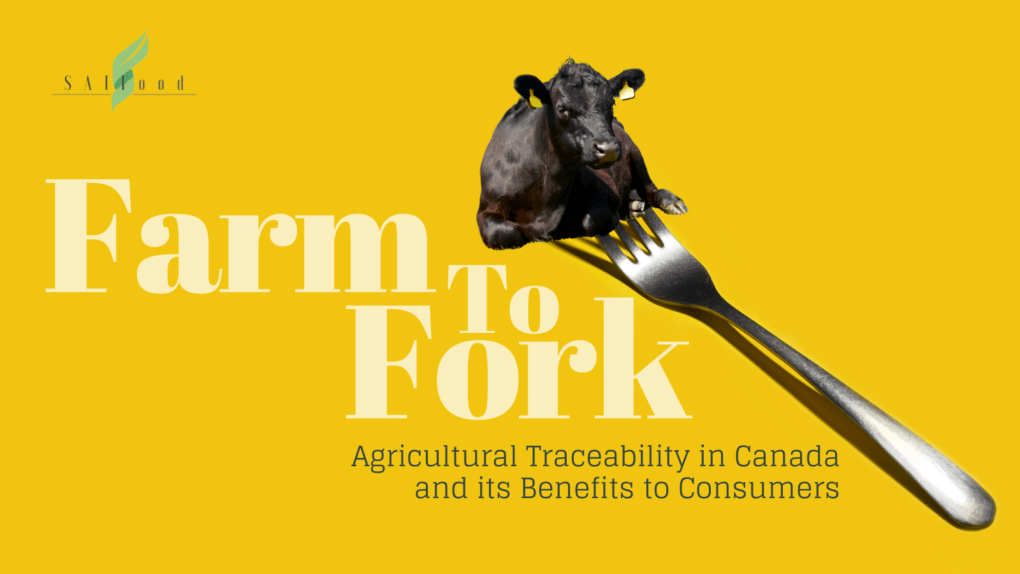By: Deanna Bysterveld, University of Saskatchewan student
Recent years have shown an increase in the consumer demand for a greater public knowledge of the safety and quality of Canadian agricultural products (Hobbs, Bailey, Dickinson, & Haghiri, 2005). Consumers want to know, now more than ever, what exactly they are feeding their families. Genetically modified organisms, for example, have become a topic widely discussed in Canada over the last two decades. More recently, the topic of traceability in agriculture has sparked a conversation about food safety within Canada and it could be the answer to many consumer concerns.
Agricultural traceability helps stop unsafe food products before they get into the hands of consumers (Farmsoft, n.d.). Say, for example, an epidemiological outbreak of a disease such as Bovine Spongiform Encephalopathy (BSE), Foot and Mouth Disease, or the Avian Flu, were to break out on livestock farms in Canada. Another example would be the regular food recalls by the Canadian Food Inspection Agency (CFIA) often for E. Coli contaminated vegetables or other bacteria damaging to human health. How could we better handle situations like this and prevent them from happening in the future? How do we manage high consumer expectations for high-quality agricultural products? These cases are perfect examples of how traceability can be used to help answer these questions and provide an efficient response in these kinds of situations.
How does traceability work?
With a traceability system in place, we gain efficient, immediate, and up-to-date information in the case of an emergency such as a natural disaster, infectious disease outbreak, or food safety issue (Government of Canada, 2019). With this information in place, whatever situation arises can be handled quickly and with the least number of consequences to the Canadian public. Specifically, fruits and vegetables are assigned unique codes that trace them back to where they were grown, where and when they were shipped, and where they are now (Farmsoft, n.d.). Similarly, with animal products, livestock traceability begins when the animal is born and continues through the supply chain to market so that information about that specific animal is always available (Lavoie & Forest, 2009) (Figure 1). The poultry industry has already independently established a system for collecting traceability information (Government of Canada, 2019). The Government of Canada and the CFIA are currently working together with Canadian agricultural industries to better implement and develop traceability programs.

Implications of traceability
Traceability is a complicated and costly measure to put in place (Raine, 2019). It takes a lot of work from governments, farmers, and the rest of the supply chain, to get traceability to work well. One of the main reasons traceability has not been widely adopted in the past is the uncertainty of the costs associated with the implementation of a system (Dessureault, 2019). This is a concern among producers especially because they will most likely be the ones to front the cost. These are unfortunate downsides, however, the Government of Canada lists multiple positive outcomes of traceability in Canada. These include risk management of the food supply system and transmission of animal disease to the public and risk management of animal health and the Canadian animal resource base (Government of Canada, 2019).
Consumer opinion
While it is important for consumers to value and understand traceability, it is difficult to show consumers how important it truly is without an incident ever occurring in their region. In Dickinson and DeeVon’s study, participants from countries who had experienced verified incidents of BSE were the most likely to place greater value on traceability (Dickinson & DeeVon, 2005). This shows that without a health risk occurring that could have been avoided using traceability measures, chances are high that consumers do not take the time to fully understand its importance.
A research study conducted in Canada, the US, the UK, and Japan showed that consumers were willing to pay more money for products that were not only raised responsibly but also had traceability measures in place (Lavoie & Forest, 2009). Another study in China found that Chinese consumers had a willingness to pay (WTP) 10% more for products with detailed traceability information on the packaging (Jin, Zhang, & Xu, 2017). This shows that consumers are seeking peace of mind when it comes to the humane treatment of animals and the guaranteed safety of the food they are eating. The 2019 public trust report released by the Canadian Centre for Food Integrity (CCFI) states that “only one in three Canadian consumers believe Canada’s food system is headed in the right direction” (Canadian Centre for Food Integrity, 2019). This knowledge of consumers can be used by the agriculture industry to better cater to the customer base. At the same time, keeping the public safer from food recalls and potentially dangerous situations involving agricultural products.
Policy
As traceability becomes a larger part of the consumer landscape, a policy must be properly implemented to regulate traceability across the country. Not only is traceability policy necessary for the health and safety of the public, but it could be used as a strategy to regain consumer trust in Canadian agriculture. Traceability procedures should be developed using the input of the farmers who would be implementing the policies. The government will be the vessel by which policy will be implemented, but officials do not have the first-hand knowledge that those in the industry have (Lavoie & Forest, 2009). This strategic collaboration would be the most efficient way to implement traceability in a variety of agricultural industries.
Conclusion
As the consumer landscape continues to change and evolve when it comes to the consumption of agricultural products, traceability is one of the ways that those of us in the agriculture industry can meet consumer expectations. While work must still be done to develop an efficient traceability program in most agricultural industries, it will be beneficial to both consumers and people in agriculture. Policy will be important in determining the success of traceability in Canada.
[su_accordion][su_spoiler title=”References” open=”no” style=”default” icon=”plus” anchor=”” class=””][su_list icon=”icon: check” icon_color=”#47907C”]
Works Cited
Canada, G. o. (2019, September 17). Livestock Identification and Traceability. Retrieved September 30, 2020, from Canadian Food Inspection Agency: https://www.inspection.gc.ca/animal-health/terrestrial-animals/traceability/eng/1300461751002/1300461804752
Canadian Centre for Food Integrity. (2019). 2019 Public Trust research: Connecting with Canadians. CCFIA. Retrieved December 12, 2020
Dessureault, S. (2019). Costs, Benefits and Business Value of Traceability: A Literature Review. ResearchGate. doi: 10.13140/RG.2.2.27835.98086
Dickinson, D. L., & DeeVon, B. (2005, December). Experiental Evidence on Willingness to Pay for Red Meat Traceability in the United States, Canada, the United Kingdom, and Japan. Journal of Agricultural and Applied Economics, 37(3), 537-548.
Farmsoft. (n.d.). Fresh Produce Traceability. Retrieved December 19, 2020, from Farmsoft: https://www.farmsoft.com/blog/fresh-produce-traceability#:~:text=Accurate%20fresh%20produce%20traceability%20reduces,customer%20confidence%20in%20product%20quality.
Hobbs, J. E., Bailey, D., Dickinson, D. L., & Haghiri, M. (2005, February 17). Traceability in the Canadian Red Meat sector: Do Consumers Care? Canadian Journal of Agricultural Economics, 53(1), 47-65. Retrieved December 19, 2020. https://onlinelibrary.wiley.com/doi/abs/10.1111/j.1744-7976.2005.00412.x
Jin, S., Zhang, Y., & Xu, Y. (2017, July). Amount of Information and the Willingness of Consumers to pay for food traceability in China. Food Control, 77, 163-170.
Lavoie, G., & Forest, J.-F. (2009). Implementation of a Traceability System From Constraints to Opportunities for the industry: A Case Study of Quebec, Canada. International Food and Agribusiness Management Review, 12(2), 71-80.
Raine, T. (2019, July 4). Traceability utimately costs farmers. Retrieved December 19, 2020, from The Western Producer: https://www.producer.com/opinion/traceability-ultimately-costs-farmers/
[/su_list] [/su_spoiler][/su_accordion]

Deanna Bysterveld
Deanna is a fourth-year student at the University of Saskatchewan pursuing her B.SC. in Agribusiness. Deanna grew up on her parent’s dairy farm along with her two sisters near Osler, Saskatchewan. Now, she is looking forward to the opportunity to pursue a future career in agriculture working for an agribusiness firm.


